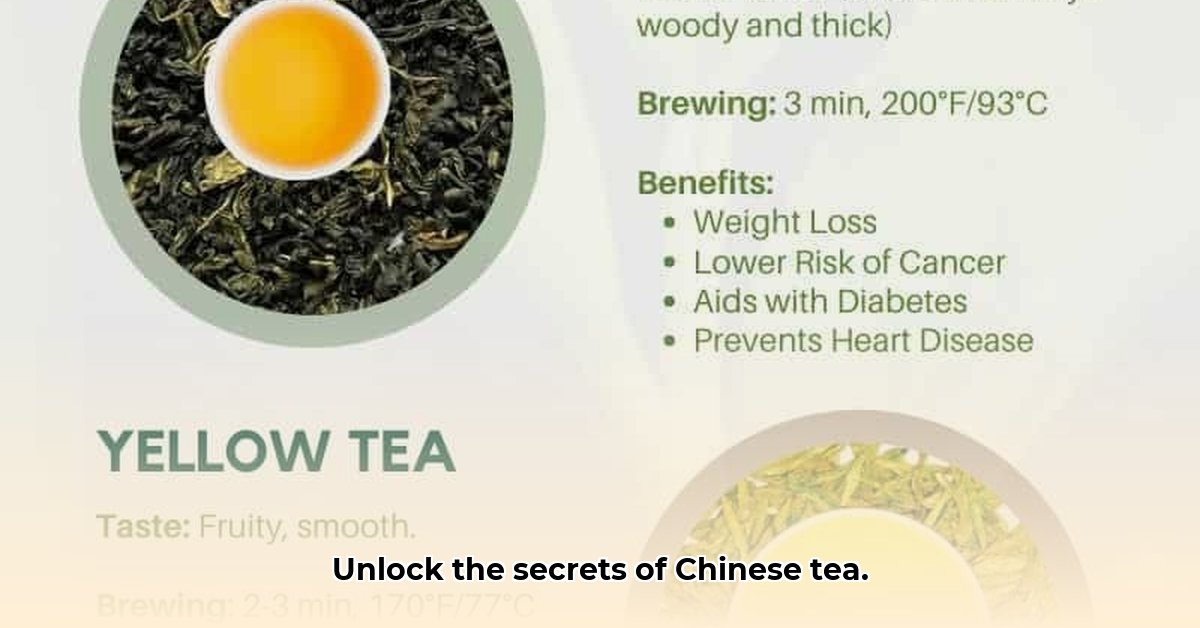
Ever wondered about the magic behind a steaming cup of Chinese tea? It's more than just a comforting beverage; it's a centuries-old tradition brimming with potential health benefits. This guide unveils the flavorful world of six main Chinese tea types – white, yellow, green, oolong, black, and dark – exploring their unique tastes and potential health advantages. We'll guide you through brewing the perfect cup, teach you to discern authentic tea, and offer ethical purchasing tips. Prepare to elevate your tea time from simple enjoyment to a mindful, healthy ritual.
Exploring the Six Main Categories: A World of Flavor and Wellbeing
From the delicate sip of white tea to the robust character of black tea, each type offers a unique experience and potential health perks. This isn't just about a tasty drink; it’s a journey into a centuries-old tradition and a path towards better wellness. Chinese tea boasts six main categories, each with unique processing methods and characteristics: white, yellow, green, oolong, black, and dark tea (like Pu-erh). These processing differences alter the tea leaves' chemical composition, resulting in a vast array of tastes and potential health benefits. It's all about how those leaves are handled!
White Tea: The Gentle Giant
White tea undergoes minimal processing, preserving its delicate buds and soft, downy hairs. This results in a subtle, light flavor. Its high polyphenol (powerful antioxidant) content is believed by some to offer significant health advantages. Consider it the purest form of tea, a taste of nature's untouched essence. Did you know that white tea is often associated with a smoother, less bitter taste than other teas?
Yellow Tea: A Golden Enigma
Yellow tea is shrouded in mystery. A unique "smothering" process lends it a mellow, smooth flavor. While research is ongoing, preliminary findings suggest impressive antioxidant properties, making it a fascinating tea to explore. Its unique processing makes it a truly intriguing choice among tea lovers. Is yellow tea's gentle flavour profile the secret to its growing popularity?
Green Tea: Vibrant and Versatile
Green tea, with its minimal processing, retains its bright green color and fresh flavor. It's renowned for its refreshing taste and abundant antioxidants. Numerous studies have explored its potential cardiovascular benefits. High-quality green tea is a real treat—a crisp, clean taste perfect for any time of day. Research suggests that green tea's antioxidants may contribute to heart health, but further studies are required to confirm this fully.
Oolong Tea: The Shape-Shifting Tea
Oolong tea uniquely bridges the gap between green and black teas. Its oxidation level (air exposure) dramatically influences its flavor profile, ranging from lightly floral to intensely roasted. It's a chameleon, changing its character depending on processing. Oolong tea's versatility allows for a wide range of flavors depending on how it's processed.
Black Tea: Bold and Beautiful
Black tea, fully oxidized, delivers a rich, robust flavor. Its deep, dark color reflects its strong taste, making it the perfect comforting beverage, especially on a chilly day. Its antioxidants and caffeine content might contribute to several health benefits. Black tea's versatility allows for countless ways to enjoy it—from classic milk tea to complex blends. Did you know that black tea's caffeine content can provide a gentle energy boost?
Dark Tea (Pu-erh): The Aged Wonder
Dark tea, particularly Pu-erh, undergoes post-fermentation or aging, resulting in earthy, complex flavors that deepen over time. Tradition suggests it aids digestion, making it a popular post-meal beverage. It's a tea that only improves with age. The unique aging process of Pu-erh tea contributes to its complex, earthy flavor profile.
Potential Health Benefits: A Balanced Perspective
Many studies suggest Chinese tea may offer various health benefits, often linked to its high antioxidant and polyphenol content. Some research links it to improved heart health, stronger immunity, and potential anti-cancer effects. However, it's crucial to note that more comprehensive, long-term studies are needed to confirm these findings definitively. The research is ongoing, and conclusions may evolve. "While promising, it's important to remember that these potential benefits require further research for conclusive evidence," says Dr. Anya Sharma, PhD, Nutritional Scientist at the University of California, Berkeley.
Brewing the Perfect Cup: A Step-by-Step Guide
The key to a great cup of tea is attention to detail: water temperature and steeping time are crucial.
- White & Green Tea: Use 170-180°F (77-82°C) water and steep for 2-3 minutes.
- Lighter Oolong Tea: Use 185-195°F (85-91°C) water and steep for 3-5 minutes.
- Darker Oolong Tea: Use 195-205°F (91-96°C) water and steep for 3-5 minutes.
- Black & Dark Tea: Use 200-212°F (93-100°C) water and steep for 3-5 minutes.
Remember, these are guidelines. Experiment to find what tastes best to you!
Choosing Your Tea: Authenticity and Ethical Considerations
With numerous teas available, choosing wisely is paramount. Opt for reputable sellers transparent about sourcing and production. Supporting sustainable farming practices ensures a healthier planet and better-quality tea.
Your Tea Journey Begins Now
The world of Chinese tea is vast and exciting. By understanding the different types, processing methods, and potential health benefits, you can embark on a personalized tea journey. So, grab your favorite mug, steep a cup, and savor the experience – your perfect cup awaits!